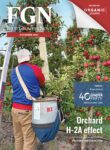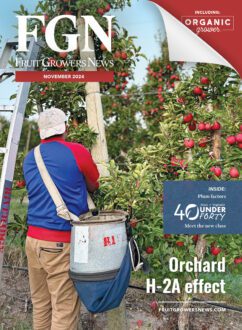Apr 1, 2010Canada’s Dwarf Sour Cherries Conducive to Machine Harvest
By Matt Milkovich, Managing Editor
The University of Saskatchewan in Saskatoon, Canada, has bred dwarf sour cherries (also called prairie sour cherries) with good fruit quality that can be harvested by machine, said Bob Bors, an assistant professor with the university’s Plant Sciences Department.
Dwarf sour cherries in Canada (Canadian growers still refer to tart cherries as “sour”) are the result of a breeding program that goes back to the 1940s. The dwarfs’ ancestors include Siberian and European varieties (with a little bit of Minnesota in there, too). The University of Saskatchewan took over the breeding program in the 1980s and continued making crosses. Bors joined the program in 1999 and put an emphasis on breeding for mechanical harvest.
It occurred to Bors that the bush-like sour cherry trees, which ranged in height from 6 to 8 feet, could be harvested using the same machines that harvest Saskatoon berries. He started selecting for traits like tree shape, pulling ability – anything conducive to mechanical harvest.
Today, there are roughly 2,000 acres or so of dwarf sour cherry trees growing in Canada, mostly in the Saskatchewan-Alberta region. U.S. growers have shown some interest, too. Researchers in Michigan are experimenting with them, Bors said, and there might be breeding efforts using similar breeding material going on in Russia.
Canadian dwarf sour cherry trees are not grafted. Most Saskatoon growers now use the JOANNA-3 to harvest them – a Polish machine originally designed to harvest black currants, he said.
Saskatchewan growers started growing the Carmine Jewel variety seven or eight years ago, followed by the “Romance” series a couple of years after that: Romeo, Juliet, Valentine, Cupid and Crimson Passion. Carmine Jewel is the first to ripen, near the end of July. The others start ripening a couple of weeks later – but those ripening times are for the Canadian prairies. The cherries are likely to ripen earlier when grown further south, he said.
Bors usually recommends Romeo and Juliet as the best all-around varieties – for the Canadian prairies, at least.
Dwarf sour cherries have some qualities that make them stand out from their redder cousins. They’re firmer than the popular variety Montmorency, for one thing, and they’re darker. North Americans (including Canadians) are used to “tart” or “sour” cherries being bright red because of the popularity of Montmorency, even though most of the world’s sour cherry varieties are dark. When the University of Saskatchewan used northern European varieties as breeding parents, almost all those parents were dark types. While the university has some bright-red cherries in its collection, it deliberately chose to release dark cherries in hopes of breaking into new markets where a dark cherry might give an advantage, Bors said.
Dwarfs have other advantages: In a freeze-thaw test, other cherries will lose 60 percent of their juice, but dwarf varieties only lose 40 percent. Their sugar content is fairly high, too, with an average range of 18-22 Brix – though Bors isn’t sure if that’s because of genetics or the Saskatchewan climate, which is sunny and dry during ripening.
Saskatoon is in hardiness zone 2, and temperatures there can reach minus 40˚ F in winter. Because of its dry climate, growers and breeders there don’t worry too much about rot and disease, but they do worry about dehydration. Growers in Ontario, a more humid climate, have problems with leaf spot disease, he said.














